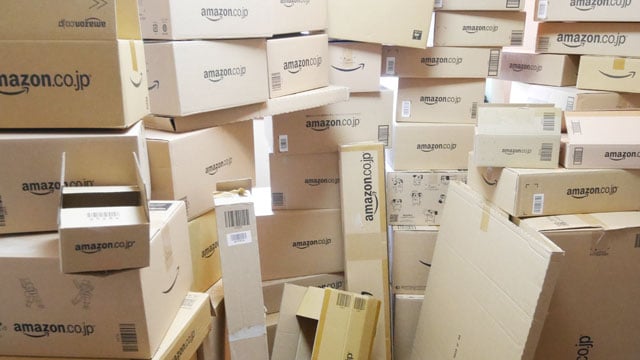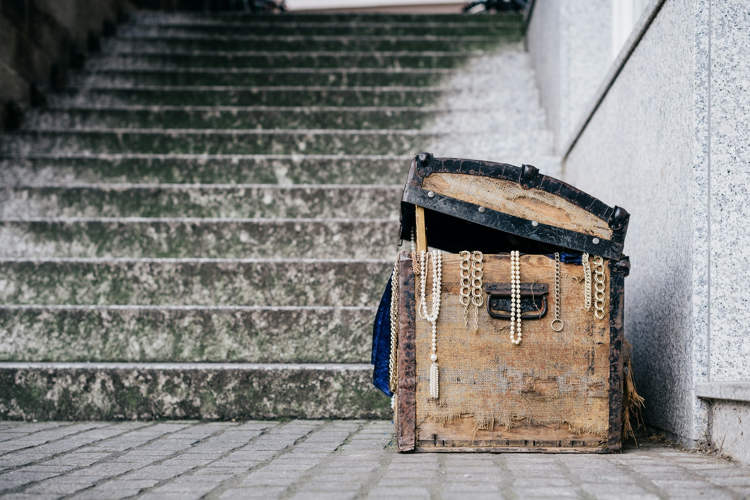When receiving an order from Amazon, most people throw way the packaging box immediately, but one Japanese man loves Amazon boxes so much that he has spent the last 9 years collecting them.
So what posses a man to start collecting Amazon cardboard boxes? In the case of Kosuke Saito, from Osaka, Japan, it was the discovery of a pattern of numbers. It all started one day, in 2008, when, while unpacking an Amazon product, he noticed the serial number “XM06” on the packaging and remembered seeing “XM08” on another Amazon box. That got him thinking that if there was an XM06 and an XM08, surely there must be an XM07 as well. He wanted to know what that box was like, but it was only the beginning, because he soon discovered that Amazon boxes come in all shapes and sizes, and he was curious about all of them.

Photo: Kosuke Saito/Nifty
Saito started ordering different size products in order to obtain different types of Amazon boxes, and eventually figured out that he had to buy specific products in order to get his hands on rarer boxes. For example, his prized XY36 model is very thin, and only used for articles like a cutting mat. In the 9 years since he started collecting Amazon cardboard boxes, Kosuke Saito has collected 77 different models used in Japan, some of which have been discontinued.
While I can (sort of) understand his fascination for the numerical sequence that kicked off his collecting habit, such numbers are everywhere, why focus on Amazon boxes, of all things. Well, apparently part of the draw is the mystery surrounding them. On his Nifty page, Saito writes that Amazon doesn’t disclose the exact types of boxes they use, it’s a closely guarded secret, for some reason, and they don’t just ship them to collectors either. The only way to add to your collection is to order products and pray that they come in a box model that you don’t already have. This makes completing your collection even harder than completing your Pokemon Pokedex.
The difficulty of obtaining different boxes is also a big draw to Kosuke Saito and other members of the Japanese community of Amazon box collectors (yes, such a thing apparently exists). For example, several same size boxes have different serial numbers, and the differences between them can be minuscule – like the bottom of the box consisting of two or four cardboard flaps – and while no one knows the reason for these differences, they are quite fascinating to collectors.
Also, sometimes ordering a specific size product doesn’t come in the type of box you assume it would. “The train of thought ‘if I purchase an item about this big I can get this one box for sure’ doesn’t really work for the users,” Saito says. Sometimes you order a single book, and it comes in an unnecessarily large box, which makes it very difficult to add new models to a collection. No one really knows why that happens, but it’s apparently part of the fun of collecting this specific type of item.
Finally, there is the generation change. Every few years, Amazon discontinues a generation of boxes along with their range of serial numbers, which basically resets Kosuke Saito’s collection. He doesn’t throw away his discontinued models, but the change makes his efforts to complete an entire generation almost impossible.
Last year, Amazon finally disclosed that they are currently using 90 different types of cardboard boxes in Japan. Saito says that he currently owns 46 of them, which puts his collection at over 50%. He is very proud of that, but knows that reaching 100% is incredibly difficult, especially with an imminent generation change.
One of the greatest challenges a Japanese Amazon box collector faces is lack of space. Japanese homes are notoriously small, and having a bunch of empty cardboard boxes lying around can become a serious problem. Saito himself carefully folds some of his 77 boxes and neatly arranges them so that they take up less space, but some of them are left intact and take up entire shelve racks.
When Kosuke got married, he was powerless to argue with his wife. She told him “Do not bring the cardboard boxes into the new house,” so he had to rent a separate storage room for his prized collection. Some of them had been with him for nearly a decade, and he couldn’t bear to throw them away.
Kosuke Saito says he is often asked why he doesn’t collect American Amazon boxes too, to which he always he replies that he finds them “kind of tasteless” compared to the works of art used in Japan.
So there you have it, the fascinating life of a Japanese Amazon box collector.






